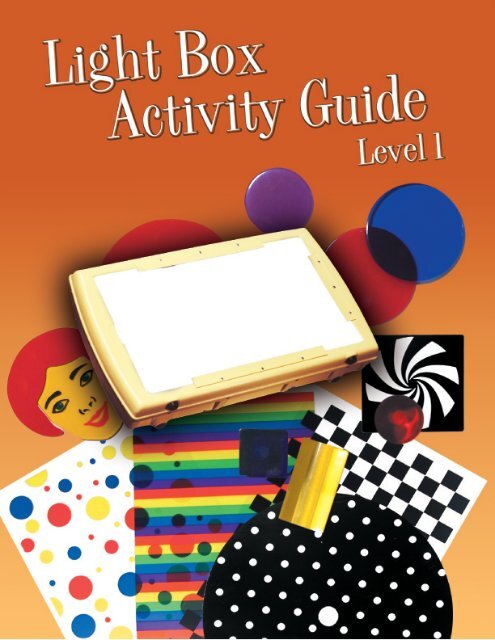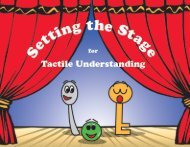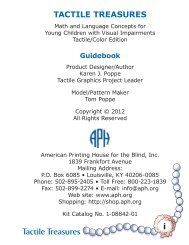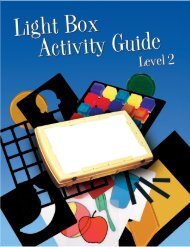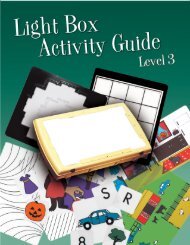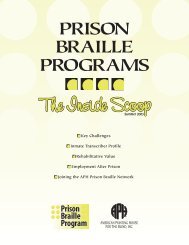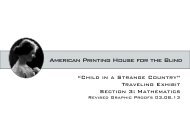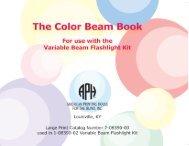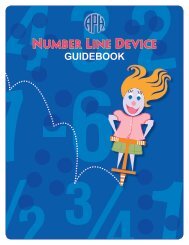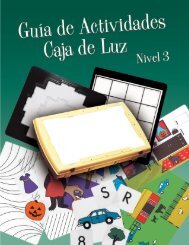Light Box Activity Guide Level 1 - American Printing House for the ...
Light Box Activity Guide Level 1 - American Printing House for the ...
Light Box Activity Guide Level 1 - American Printing House for the ...
You also want an ePaper? Increase the reach of your titles
YUMPU automatically turns print PDFs into web optimized ePapers that Google loves.
<strong>Light</strong> <strong>Box</strong><strong>Activity</strong> <strong>Guide</strong><strong>Level</strong> 1Suzette WrightProject DirectorAMERICAN PRINTING HOUSE FOR THE BLINDP.O. <strong>Box</strong> 6085Louisville, Kentucky 40206-0085i
© 1983, 2004 <strong>American</strong> <strong>Printing</strong> <strong>House</strong> <strong>for</strong> <strong>the</strong> Blind, Inc.All rights reserved.ii
ContentsPageIntroduction ................................................................ vAcknowledgments ..................................................... viKit Items .....................................................................1Safety .........................................................................4<strong>Guide</strong>lines and Suggestions ......................................6The Child with Cortical Visual Impairment................ 11Maintenance.............................................................16Additional Materials ..................................................19Suggested Readings ................................................27<strong>Activity</strong> Index ............................................................32Activities ...................................................................33Appendix: Vision Development Materialsfrom APH & Related Visual Tasks Chart ..................75iii
IntroductionThe APH <strong>Light</strong> <strong>Box</strong> was designed at <strong>the</strong> request of teachersfamiliar with <strong>the</strong> needs of developmentally young childrenwith limited vision. A number of programs serving youngvisually impaired children have constructed devices similarto <strong>the</strong> <strong>Light</strong> <strong>Box</strong> and have found <strong>the</strong>m useful in teachingbasic visual skills as well as more complex visual-motor andvisual-perceptual skills. The aim in developing <strong>the</strong> APH<strong>Light</strong> <strong>Box</strong> was to create a safe, portable version of <strong>the</strong>seteacher-made devices, equipped with a rheostat and prop toincrease versatility.Thirteen items have been developed <strong>for</strong> <strong>the</strong> <strong>Light</strong> <strong>Box</strong> andincluded in a <strong>Level</strong> I Kit <strong>for</strong> use with children functioning frombirth to four years. The accompanying written activitiesprovide practice in <strong>the</strong> per<strong>for</strong>mance of basic visual skills,eye-hand coordination tasks, and beginning matching anddiscrimination exercises.The <strong>Light</strong> <strong>Box</strong> and <strong>Level</strong> I Materials were not designed toprovide a comprehensive program of vision trainingactivities; <strong>the</strong>y should be used in conjunction with o<strong>the</strong>rmaterials. The <strong>Light</strong> <strong>Box</strong> Materials can, however, play a veryuseful role in vision training. The high contrast backgroundaf<strong>for</strong>ded by <strong>the</strong> <strong>Light</strong> <strong>Box</strong>’s illuminated surface makes avariety of visual tasks easier to per<strong>for</strong>m. In addition, <strong>the</strong>brightly colored items used on <strong>the</strong> <strong>Light</strong> <strong>Box</strong> are attractive,and <strong>the</strong> novelty of <strong>the</strong> materials motivates students to utilize<strong>the</strong>ir vision.v
AcknowledgmentsA number of people participated in <strong>the</strong> development andevaluation of <strong>the</strong> APH <strong>Light</strong> <strong>Box</strong> and <strong>the</strong> accompanying<strong>Level</strong> I Materials.Tom Poppe, a member of <strong>the</strong> Design and Development staffat APH, designed and built <strong>the</strong> <strong>Light</strong> <strong>Box</strong> and constructed <strong>the</strong>various items to be used with it.Kay Ferrell, Preschool Consultant <strong>for</strong> <strong>the</strong> <strong>American</strong>Foundation <strong>for</strong> <strong>the</strong> Blind, served as <strong>the</strong> project’s primaryconsultant. Ruth Holmes, coordinator and educator of lowvision students at <strong>the</strong> Illinois School <strong>for</strong> <strong>the</strong> Visually Impairedserved as consultant <strong>for</strong> <strong>the</strong> organization and content of <strong>the</strong>guidebook’s written activities.The following evaluated <strong>the</strong> <strong>Light</strong> <strong>Box</strong> Materials withstudents during <strong>for</strong>mative and field tests:Mark Bane, Teacher, Dallas Services <strong>for</strong> Visually ImpairedChildren, Dallas, TexasEllen Bernstein, Infant Specialist, Virginia Department <strong>for</strong> <strong>the</strong>Visually Handicapped, Richmond, VirginiaRebecca Brown, Teacher, Nina Harris Exceptional StudentEducation, Pinellas Park, FloridaChris Curtis, Supervisor of Deaf-Blind Department, ColoradoSchool <strong>for</strong> <strong>the</strong> Deaf and Blind, Colorado Springs,Coloradovi
Susan DeCaluwe, Supervisor of Multihandicapped Program,Meyer Children’s Rehabilitation Institute, Omaha,NebraskaCarmella Gates, Assistant Professor, University of Nor<strong>the</strong>rnColorado, Greeley, ColoradoJay Greeley, Vision Resource Teacher, Sullivan School,Denver, ColoradoDiana Laird, Teacher, Nina Harris Exceptional StudentEducation, Pinellas Park, FloridaJudy McGruder, Teacher, Kentucky School <strong>for</strong> <strong>the</strong> Blind,Louisville, KentuckyDejean Miller, Infant Teacher, Education Service Center,Region XV, San Angelo, TexasElizabeth Morgan, Teacher, Colorado School <strong>for</strong> <strong>the</strong> Deafand Blind, Colorado Springs, ColoradoJudy Murray, Supervisor of Deaf-Blind Department,Kentucky School <strong>for</strong> <strong>the</strong> Blind, Louisville, KentuckyLinda Westover, Teacher, Colorado School <strong>for</strong> <strong>the</strong> Deaf andBlind, Colorado Springs, ColoradoJeanna Wilson, Teacher, Dallas Services <strong>for</strong> VisuallyImpaired Children, Dallas, Texasvii
viii
Kit ItemsAcetate Backgrounds1 red1 blue1 yellow1 green2 clearBlackout Backgrounds1 with 8 1/2" x 11" opening1 with 4" x 4" openingTracing Backgrounds1 with thick wavy line1 with thin zig-zag linePattern Backgrounds2 striped1 checkerboard1 figuredTemplate Backgrounds1 circle1 triangle1 square1 circle and triangle1 circle and square1 triangle and square1 triangle, square, and circle1 twelve small circles1
Plexiglas ® Blocks12 small circles in six colors3 small squares in red, blue, and yellow3 large squares in red, blue, and yellow3 small triangles in red, blue, and yellow3 large triangles in red, blue, and yellow6 large circles – two each in red, blue, and yellowOpaque Shapes4 large circles4 large squares4 large trianglesPlexiglas ® Spinner1 spinner1 set pinwheel patterns1 set polka dot patternsPlexiglas ® Face PuzzlePlexiglas ® Ball Puzzles1 frame1 two-piece puzzle1 four-piece puzzle2
Threading Beadslarge colored beads1 ropeColored Transparent Tumblers2 red2 blue2 yellow2 green8 Suction Cup Knobs3
Safety1. No child should use <strong>the</strong> <strong>Light</strong> <strong>Box</strong> unless he is directlysupervised by a teacher or o<strong>the</strong>r adult familiar with <strong>the</strong>following safety instructions and <strong>Guide</strong>lines andSuggestions section of <strong>the</strong> <strong>Activity</strong> <strong>Guide</strong>.2. Check <strong>the</strong> <strong>Light</strong> <strong>Box</strong> be<strong>for</strong>e each use <strong>for</strong> any damage to<strong>the</strong> unit, such as exposed electrical components, frayedcord, or any o<strong>the</strong>r potential hazard.3. The <strong>Light</strong> <strong>Box</strong> will not operate if it is cold (below 50º F).Allow time <strong>for</strong> <strong>the</strong> unit to reach room temperature if it hasbeen stored several hours at 50º F or below.4. Operate only on 120 V AC, 60 cycle electrical outlets.5. The consumer should not defeat <strong>the</strong> three-prong,grounded supply line.6. Do not operate without a tube in <strong>the</strong> sockets.7. Check to see that <strong>the</strong> Plexiglas work surface is securelyin place whenever <strong>the</strong> <strong>Light</strong> <strong>Box</strong> is in use. Do notremove <strong>the</strong> work surface unless <strong>the</strong> unit is disconnected.8. Do not cover or obstruct <strong>the</strong> <strong>Light</strong> <strong>Box</strong>’s vents, or permit<strong>the</strong> child to stick fingers or objects of any kind in <strong>the</strong>m.(See diagram, page 18).9. Do not allow <strong>the</strong> child to play with <strong>the</strong> electrical cord,plug, or hinged prop.4
10. Do not permit <strong>the</strong> child to drop, hit, stand, or sit on <strong>the</strong><strong>Light</strong> <strong>Box</strong> or engage in any o<strong>the</strong>r activity which mightdamage <strong>the</strong> unit or expose electrical components.11. Keep <strong>the</strong> <strong>Light</strong> <strong>Box</strong> away from liquid or moisture. Whenusing acetate sheets <strong>for</strong> marking on, withdraw <strong>the</strong> sheetfrom <strong>the</strong> <strong>Light</strong> <strong>Box</strong> to clean. If it is necessary to clean <strong>the</strong><strong>Light</strong> <strong>Box</strong>, disconnect it and wipe with a damp, not wet,cloth.12. Do not operate <strong>the</strong> <strong>Light</strong> <strong>Box</strong> continuously <strong>for</strong> more than8 hours. This will prevent excessive heat buildup within<strong>the</strong> unit.13. The <strong>Light</strong> <strong>Box</strong> will get moderately warm during normaloperation. However, if it becomes quite hot to <strong>the</strong> touch,disconnect <strong>the</strong> unit. Be<strong>for</strong>e using <strong>the</strong> <strong>Light</strong> <strong>Box</strong> again,have it checked by technical personnel.NOTE TO THE CONSUMER:The <strong>Light</strong> <strong>Box</strong> is approved.5
<strong>Guide</strong>lines and SuggestionsIn November 2002, government regulationsconcerning electronic components <strong>for</strong>ced a changein <strong>the</strong> ballast/dimmer system used in <strong>the</strong>APH <strong>Light</strong> <strong>Box</strong>.Please be advised that <strong>the</strong> new system willproduce a single flash of light when <strong>the</strong> unit isswitched on. To avoid startling <strong>the</strong> student orexposing a light-sensitive student, we suggestcovering <strong>the</strong> <strong>Light</strong> <strong>Box</strong> be<strong>for</strong>e switching it on or turn<strong>the</strong> unit on be<strong>for</strong>e positioning <strong>the</strong> student nearby.1. When using <strong>the</strong> <strong>Light</strong> <strong>Box</strong>, place it in a darkened cornerof <strong>the</strong> room, positioned so that o<strong>the</strong>r children will notcome in contact with it or its electrical cord.2. Examine <strong>the</strong> <strong>Light</strong> <strong>Box</strong> <strong>for</strong> flickering to guard againstseizuring in a seizure-prone child. The <strong>Light</strong> <strong>Box</strong> mayflicker on low intensities, particularly when new. Thisshould decrease after <strong>the</strong> first few weeks of use. Iffeasible, leave <strong>the</strong> <strong>Light</strong> <strong>Box</strong> on <strong>for</strong> several hours eachday <strong>the</strong> first week you use it to help “age” <strong>the</strong> lamp/dimmer system.3. If a child is seizure-prone, be cautious about presentingitems or displays on <strong>the</strong> <strong>Light</strong> <strong>Box</strong> which move in arhythmic, patterned manner.6
4. If a child is sensitive or averse to light, it may be helpfulto introduce <strong>the</strong> <strong>Light</strong> <strong>Box</strong> with overhead lights on. Set<strong>the</strong> dimmer at a medium intensity, and/or decrease <strong>the</strong>size of <strong>the</strong> illuminated area by using one of <strong>the</strong> “blackout”backgrounds. Placing one of <strong>the</strong> colored acetate sheetsor a pattern on <strong>the</strong> <strong>Light</strong> <strong>Box</strong> may also reduce <strong>the</strong>intensity of <strong>the</strong> light. Experiment to find <strong>the</strong> conditionswhich maximize <strong>the</strong> child’s visual functioning.5. For <strong>the</strong> child with sufficient vision who is rein<strong>for</strong>ced bylight or <strong>the</strong> novelty of <strong>the</strong> <strong>Light</strong> <strong>Box</strong>, try working withoverhead illumination and set <strong>the</strong> <strong>Light</strong> <strong>Box</strong> at a mediumor low intensity. As <strong>the</strong> child per<strong>for</strong>ms an activity on <strong>the</strong><strong>Light</strong> <strong>Box</strong>, rein<strong>for</strong>ce his appropriate responses by turningup <strong>the</strong> intensity of <strong>the</strong> <strong>Light</strong> <strong>Box</strong> <strong>for</strong> a few seconds; <strong>the</strong>nreturn <strong>the</strong> intensity to a lower setting to be ready toreward <strong>the</strong> next correct response.6. Use <strong>the</strong> <strong>Light</strong> <strong>Box</strong> in a variety of positions (horizontal,vertical, angled) and place <strong>the</strong> child in a com<strong>for</strong>tableposture (sitting at a table or on <strong>the</strong> floor, lying on her side,resting over a wedge or bolster). Check with <strong>the</strong> child’sphysical <strong>the</strong>rapist to find which positions are best <strong>for</strong> her.Note which postures enhance her visual functioning.7. Present <strong>the</strong> <strong>Light</strong> <strong>Box</strong> at varying distances and areas inrelation to <strong>the</strong> child’s body and watch him to see whe<strong>the</strong>rhe demonstrates a preference.8. When presenting items on <strong>the</strong> <strong>Light</strong> <strong>Box</strong>, put <strong>the</strong>m indifferent places on <strong>the</strong> work surface. Note whe<strong>the</strong>r <strong>the</strong>child responds consistently and accurately to <strong>the</strong> items7
egardless of <strong>the</strong>ir location, or, instead, shows signs of afield defect. For example, if <strong>the</strong> child tilts her head to oneside, appears to be using only one eye, or reaches <strong>for</strong>objects on one side only, <strong>the</strong>re may be a field loss or <strong>the</strong>child may have difficulty crossing <strong>the</strong> midline. This willaffect <strong>the</strong> manner in which you present activities.9. Use <strong>the</strong> colored acetate sheets and objects and observewhe<strong>the</strong>r <strong>the</strong> child prefers one color over ano<strong>the</strong>r.10. If <strong>the</strong> child has difficulty manipulating items on <strong>the</strong> <strong>Light</strong><strong>Box</strong> because of <strong>the</strong>ir tendency to slip, use masking tapeto attach a large square of clear contact paper, with itsadhesive side up, to <strong>the</strong> <strong>Light</strong> <strong>Box</strong> surface. At first, <strong>the</strong>contact paper may be too sticky, but with a little use it willprovide a nonslip surface.11. If <strong>the</strong> child has difficulty picking up <strong>the</strong> Plexiglas puzzlepieces and shapes, attach <strong>the</strong> suction cup knobsprovided with <strong>the</strong> kit to <strong>the</strong>se items.12. Use words like “look,” “see,” and “find” when presentingitems on <strong>the</strong> <strong>Light</strong> <strong>Box</strong> work surface. Encourage <strong>the</strong> childand describe <strong>for</strong> him what he is seeing – its shape, size,position, and color.13. Show enthusiasm <strong>for</strong> each activity you per<strong>for</strong>m with <strong>the</strong>child, and use strategies that are particularly motivatingto her. Show <strong>the</strong> child a new activity, <strong>the</strong>n ask her toper<strong>for</strong>m it. Provide verbal and physical prompts whennecessary.8
14. Praise <strong>the</strong> child’s appropriate responses. It is importantto immediately rein<strong>for</strong>ce correct responses with things<strong>the</strong> child finds motivating – a hug, verbal praise,applause, etc.15. If <strong>the</strong> child engages in a disruptive behavior while workingwith <strong>the</strong> <strong>Light</strong> <strong>Box</strong>, try dimming or turning <strong>the</strong> <strong>Light</strong> <strong>Box</strong> offas a means of discouraging off-task behavior.16. If <strong>the</strong> child engages in self-stimulation activities whenusing <strong>the</strong> <strong>Light</strong> <strong>Box</strong>, such as light gazing or flicking, turn<strong>the</strong> <strong>Light</strong> <strong>Box</strong> off <strong>for</strong> several seconds. When <strong>the</strong> child hasstopped self-stimulating, turn <strong>the</strong> <strong>Light</strong> <strong>Box</strong> back on andresume <strong>the</strong> activity. If he, begins to self-stimulate again,repeat <strong>the</strong> procedure. If self-stimulation continues afterseveral trials, end <strong>the</strong> session; note <strong>the</strong> stimulusconditions which cause <strong>the</strong> child to self-stimulate. At <strong>the</strong>next session, avoid <strong>the</strong>se stimuli as much as possible.Try reducing <strong>the</strong> intensity of <strong>the</strong> <strong>Light</strong> <strong>Box</strong> and/or <strong>the</strong>amount of illuminated surface area. Turn on <strong>the</strong> roomlights or use <strong>the</strong> colored acetate sheets as backgrounds<strong>for</strong> <strong>the</strong> activities. Continue to turn <strong>the</strong> <strong>Light</strong> <strong>Box</strong> off when<strong>the</strong> child self-stimulates, reintroducing it when he stops.If <strong>the</strong> child continues to self-stimulate withoutimprovement after several sessions of following thisprocedure, discontinue use of <strong>the</strong> <strong>Light</strong> <strong>Box</strong> <strong>for</strong> severaldays. When you reintroduce it, you may attempt toeliminate self-stimulation in some o<strong>the</strong>r way. Forexample, try rewarding <strong>the</strong> child after periods of time inwhich he does not self stimulate, gradually increasing <strong>the</strong>length of time you require him not to self-stimulate. Work9
with <strong>the</strong> child using o<strong>the</strong>r vision stimulation and trainingmaterials; it may be that <strong>the</strong> <strong>Light</strong> <strong>Box</strong> is not anappropriate tool <strong>for</strong> him at this point. Brightly colored orreflective objects, fluorescent materials, a penlight withcolor caps, and o<strong>the</strong>r items may elicit more appropriatevisual responses from some children.17. As <strong>the</strong> child develops new skills, continue to practice andbuild upon skills learned earlier.18. To transfer a skill learned on <strong>the</strong> <strong>Light</strong> <strong>Box</strong> to a normallylit environment, increase room illumination as yougradually decrease <strong>the</strong> intensity of <strong>the</strong> <strong>Light</strong> <strong>Box</strong>. As youdecrease <strong>Light</strong> <strong>Box</strong> intensity, some of <strong>the</strong> Plexiglasmaterials will begin to appear dark and without color.Exchange <strong>the</strong>m <strong>for</strong> o<strong>the</strong>r highly contrasting brightlycolored toys.19. <strong>Light</strong> <strong>Box</strong> activities should be used as a part of a totalprogram of visual development. (See SuggestedReadings.) The written activities accompanying <strong>the</strong><strong>Light</strong> <strong>Box</strong> are not intended to provide a comprehensiveprogram of vision stimulation and training activities.10
The Child with Cortical Visual Impairment:Considerations <strong>for</strong> per<strong>for</strong>ming Activities with <strong>the</strong><strong>Light</strong> <strong>Box</strong>The child diagnosed with Cortical Visual Impairment may notrespond to <strong>the</strong> activities suggested <strong>for</strong> <strong>the</strong> <strong>Light</strong> <strong>Box</strong> in <strong>the</strong>same manner as a child whose vision loss is due to ocularabnormalities. The child whose vision loss is due to damageto <strong>the</strong> visual cortex and/or posterior visual pathways is saidto have Cortical Visual Impairment (CVI) (Groenveld, Jan &Leader, 1990). Damage may be caused by cerebral hypoxia;o<strong>the</strong>r causes include cytoplasmosis, toxoplasmosis,meningitis, trauma, and conditions causing cerebraldegeneration. (Merrill & Kewman, 1986).The agent causing CVI may cause additional differences in<strong>the</strong> functioning of <strong>the</strong> child’s brain and nervous system. Ithas been observed that many children with CVI are easilyoverstimulated, a difficulty which may be associated with aninability of <strong>the</strong> nervous system to selectively attend toimportant stimuli and screen out irrelevant stimuli in <strong>the</strong>environment. The child is flooded with many types of stimuliwithout a sufficient means to sort out and disregard <strong>the</strong>excess. Overstimulation, it has been <strong>the</strong>orized, may trigger<strong>the</strong> child’s withdrawal, which serves as a protectiveresponse, shielding him from fur<strong>the</strong>r overstimulation and <strong>the</strong>resulting stress. (Groenveld, Jan & Leader, 1990; Morse,1990). For this reason, intense visual displays, or o<strong>the</strong>rintense stimuli, should be avoided, as a child with CVI mayexperience discom<strong>for</strong>t and withdraw, even if he initiallyshows signs of visual attention.11
The literature suggest <strong>the</strong> following considerations mayapply in per<strong>for</strong>ming activities on <strong>the</strong> <strong>Light</strong> <strong>Box</strong> with a childwho has CVI.• Intense visual displays and overstimulation of any kindshould be avoided.• Be very cautious about presenting any visual displaywith movements, shifting patterns, or flickering light.These may trigger a seizure in some children; consult<strong>the</strong> child’s physician be<strong>for</strong>e introducing <strong>the</strong>se(Groenveld, Jan & Leader, 1990).• The child’s cues should be carefully attended to, notingwhen he is ready <strong>for</strong> vision stimulation, and stoppingwhen he shows signs of overstimulation or tiredness(Morse, 1990).• Observation may give you some awareness of <strong>the</strong> lengthof time it takes <strong>for</strong> a particular child to process sensoryin<strong>for</strong>mation; use this awareness to time yourpresentation of materials and assist <strong>the</strong> child inorganizing his responses (Morse, 1990).• Surrounding distractions should be reduced (Morse, 1990).(The <strong>Light</strong> <strong>Box</strong> itself may be of some help in this regardsince it is most often used in a darkened environment,reducing visual input from <strong>the</strong> rest of <strong>the</strong> environment.)• Positioning <strong>the</strong> child so he is com<strong>for</strong>table and securemeans he will not need to divert energy to maintain hisposture; this may be critical to his visual per<strong>for</strong>mance.(Groenveld, Jan & Leader, 1990).12
• Taking care to introduce novel items gradually (Morse,1990), and ritualizing <strong>the</strong> manner in which tasks arepresented, using language to cue <strong>the</strong> child, and clearlymarking <strong>the</strong> beginning and end of tasks may lessen <strong>the</strong>chances of overstimulating him (Groenveld, Jan &Leader, 1990).• Visual displays should be simple in <strong>for</strong>m and itemsshould be presented separately or with adequate spacebetween <strong>the</strong>m, since children with CVI seem to havespecial difficulty discriminating between <strong>for</strong>eground andbackground in<strong>for</strong>mation (Groenveld, Jan & Leader,1990).• Some children with CVI are sensitive to bright light;o<strong>the</strong>rs require more light (Groenveld, Jan & Leader,1990). The <strong>Light</strong> <strong>Box</strong> should be introduced at lowillumination until you are able to determine <strong>the</strong> level thatis com<strong>for</strong>table <strong>for</strong> <strong>the</strong> child. It may be that <strong>the</strong> <strong>Light</strong> <strong>Box</strong>is not an appropriate tool <strong>for</strong> some children.• Observe <strong>the</strong> child <strong>for</strong> field losses, which may beassociated with CVI; modify his posture and yourpresentation of visual displays and tasks to accommodatesuch losses (Groenveld, Jan & Leader, 1990).• Color may help <strong>the</strong> child with CVI perceive <strong>for</strong>ms. Colorperception is usually normal in a child with CVI, however,he may respond better to bright colors than to pastels,and yellows and reds may be easiest to see (Merrill &Kewman, 1986; Powell, 1996).13
• It has been suggested that more severely affectedchildren may relate better to common objects than totoys. (Groenveld, Jan & Leader, 1990). Common objects,both opaque and colored transparent ones, may be usedon <strong>the</strong> <strong>Light</strong> <strong>Box</strong> to test this preference.14
ReferencesGroenveld, M., Jan, J.E., & Leader, P. (1990). Observationsof <strong>the</strong> habilitation of children with Cortical Visual Impairment.Journal of Visual Impairment & Blindness,84, 11-15.Merrill, M., & Kewman, D. (1986). Training of color and <strong>for</strong>midentification in cortical blindness: A case study. Archives ofPhysical Medicine and Rehabilitation, 67, 479-483.Morse, M. T. (1992). Augmenting assessment procedures <strong>for</strong>children with severe multiple handicaps and sensoryimpairments. Journal of Visual Impairment & Blindness,86, 73-77.Morse, M. T. (1990). Cortical visual impairment in youngchildren with multiple disabilities. Journal of VisualImpairment & Blindness, 84, 200-203.Powell, S. A. (1996). Neural-based visual stimulation withinfants with cortical impairment. Journal of VisualImpairment & Blindness, 90, 445-446.15
MaintenanceReplacement parts <strong>for</strong> <strong>the</strong> <strong>Light</strong> <strong>Box</strong> are available at <strong>the</strong><strong>American</strong> <strong>Printing</strong> <strong>House</strong> <strong>for</strong> <strong>the</strong> Blind, where it should bereturned if it is damaged or develops a malfunction. Repairsto <strong>the</strong> <strong>Light</strong> <strong>Box</strong> must be made in accordance with standardsset <strong>for</strong>th by Underwriters Laboratories. Technicians at <strong>the</strong><strong>American</strong> <strong>Printing</strong> <strong>House</strong> <strong>for</strong> <strong>the</strong> Blind are trained to per<strong>for</strong>msuch repairs.A worn-out bulb, however, may be replaced by <strong>the</strong> user.Replacement bulbs can be purchased from electrical supplycompanies <strong>for</strong> under $20.00. General Electric manufactures<strong>the</strong> 40 watt fluorescent U-bent tube used in <strong>the</strong> <strong>Light</strong> <strong>Box</strong>(mod-u-line, F40 SP30 U 6). Phillips manufactures a similarbulb. The average life of this particular fluorescent tube is12,000 hours, however, turning <strong>the</strong> <strong>Light</strong> <strong>Box</strong> off and onreduces its life expectancy, In addition, <strong>the</strong> bulb graduallyloses full brightness over a period of time. Watch <strong>for</strong> thisgradual dimming and replace <strong>the</strong> bulb early.To replace <strong>the</strong> bulb, UNPLUG THE LIGHT BOX be<strong>for</strong>eremoving <strong>the</strong> Plexiglas work surface. Remove <strong>the</strong> Plexiglasby pushing your finger or a penknife under <strong>the</strong> Plexiglas at<strong>the</strong> small molded depression on <strong>the</strong> left edge of <strong>the</strong> box.Slide it off <strong>the</strong> box. Four plastic ties hold <strong>the</strong> bulb in place.They can be released and should not be cut. Release eachtie by pressing down on <strong>the</strong> molded tab. Pull up on <strong>the</strong> bulb;<strong>the</strong> pins connecting <strong>the</strong> tube to <strong>the</strong> sockets should releaseeasily. Remove <strong>the</strong> old bulb and position <strong>the</strong> new bulb with<strong>the</strong> pins over <strong>the</strong> two slots in <strong>the</strong> sockets. Press <strong>the</strong> pinsdown into <strong>the</strong> slots as <strong>the</strong> rest of <strong>the</strong> bulb is lowered in place.16
The pins will make a snapping sound as <strong>the</strong>y lock in place. Itis important to secure <strong>the</strong> new bulb, reusing all four plasticties. Extra ties may also be purchased from an electricalsupply company <strong>for</strong> a few cents apiece.APH <strong>Light</strong> <strong>Box</strong>17
APH <strong>Light</strong> <strong>Box</strong>18
Additional MaterialsA number of readily available commercial items can be usedon <strong>the</strong> <strong>Light</strong> <strong>Box</strong> <strong>for</strong> activities involving shape, color, and sizediscrimination, drawing, and prewriting tasks. Cut and pasteor draw colored shapes, patterns, and pictures on a varietyof background media. Create cards or board games to teachmatching. Duplicate worksheets shown in <strong>the</strong> <strong>Activity</strong> Sheetsbooklet, or provide <strong>the</strong> child with <strong>the</strong> materials to createoriginal artwork—drawings, or collages.Acetate Sheets (clear and transparent colored sheets ina variety of sizes; available from art and school supplystores, and Dick Blick catalog)Photocopier Acetate (specially treated clear 8-1/2 x 11inch acetate sheets may be used in some photocopiersin place of paper, producing acetate copies of paperoriginal; available from office supply stores, Dick Blickcatalog)Art Film (brightly colored transparent film has anadhesive backing, sold in sheets and as rolls of tape ofvarious widths; may be cut to any shape; available fromart supply stores, Dick Blick catalog)“MonoKote” (brightly colored transparent film adheres toany surface when heated with iron; sold in rolls, may becut to any shape; available from hobby stores which sellmodel-building materials)19
Onionskin or Tracing PaperColored CellophaneColored Tissue PaperColored and Patterned Wrapping PaperColored and Patterned FabricColored Projection Markers (water soluble or permanentink markers; adheres to acetate; available from schoolsupply stores and Dick Blick catalog)Colored Grease Pencils“Cel Vinyl” (acrylic paint; highly opaque black paintadheres to acetate; apply with a brush; available fromart supply stores and Dick Blick catalog)Fingerpaints (use in clear or translucent white plastictray or Tupperware ® container)Crayons (use with onionskin or tracing paper)Black Electrical TapeColored RibbonColored YarnRickrackDoilies20
Colored Plastic ButtonsPlexiglas Sample Squares (available from companiesthat retail Plexiglas)For drawing <strong>the</strong> child’s attention to shape and <strong>for</strong> tracingaround and copying shapes, <strong>the</strong>se items may beincorporated into activities with <strong>the</strong> <strong>Light</strong> <strong>Box</strong>:CoastersCookie cuttersJello moldsStencilsWooden blocksParquetry piecesPuzzle piecesA-Z and 1-10 Panels (available from ExceptionalTeaching Aids catalog)Shape puzzles of soft rubber made by Lauri Toys(available in toy stores)Clay or Playdough ®Posterboard shapes21
Familiar objects with simple contours (a cookie, ban, barof soap, shoe, or spoon)Ink and acetate (draw your own solid or outline shapeson acetate)O<strong>the</strong>r materials which may be used with <strong>the</strong> <strong>Light</strong> <strong>Box</strong> todevelop a number of skills are:Wikki Stix ® (colored wax wicking to be bent and pressedinto a variety of shapes or construction; available fromExceptional Teaching Aids catalog)Colored transparent plastic eating utensils, glasses, andplatesColored plastic “stained glass” ornaments made fromsimple kit available from hobby shops)Brightly colored translucent or transparent plastic toys(Easter eggs, pop-beads, o<strong>the</strong>r inexpensive toys)BalloonsColored pinwheelsSmall toy carsHalloween masksPlastic Halloween pumpkinsColored plastic clo<strong>the</strong>spins22
Costume jewelry beads (available from hobby shops)Mosaic tiles (bag of 150 1/2-inch transparent plasticsquares in 16 colors; available from Dick Blick catalog)MarblesColored bath oil beadsColored transparent “gummy” candiesLifesavers ® and o<strong>the</strong>r colored transparent hard candiesand suckersConfetti made of colored acetate closed in a clearplastic bottleThe following items from <strong>the</strong> <strong>American</strong> <strong>Printing</strong> <strong>House</strong> <strong>for</strong> <strong>the</strong>Blind catalog may be used on <strong>the</strong> <strong>Light</strong> <strong>Box</strong> <strong>for</strong> discriminatingand matching shapes, tracing, and introducing part-wholerelationships:Puzzle Form Board Kit (contains three each of circles,squares, triangles, rectangles, and diamonds; some of<strong>the</strong> shapes are divided into two and three pieces, whichmust be assembled correctly to <strong>for</strong>m <strong>the</strong> shape; catalogNo. 1-03721-00)Shape Board (board itself is not suited <strong>for</strong> use on <strong>Light</strong><strong>Box</strong>, but shapes are useful; contains five shapes,including one large, one small and three medium-sizedpieces: catalog No. 1-03710-00)23
Additional MaterialsCRAYON24
Addresses<strong>American</strong> <strong>Printing</strong> <strong>House</strong> <strong>for</strong> <strong>the</strong> Blind1839 Frank<strong>for</strong>t AvenueP.O. <strong>Box</strong> 6085Louisville, KY 40206-0085Phone: 800-223-1839Fax: 502-899-2274Website: www.aph.orgChildcraft Education CorporationP.O. <strong>Box</strong> 3239Lancaster, PA 17604Phone: 800-631-5652Toll-free Fax: 888-532-4453Website: www.childcraft.comDick Blick Art MaterialsP.O. <strong>Box</strong> 1267Galesburg, IL 61401-1267Phone: 800-723-2787Fax: 800-621-8293Website: www.dickblick.com25
Exceptional Teaching Aids, Inc.20102 Woodbine AvenueCastro Valley, CA 94546Phone: 800-549-6999Fax: 510-582-5911Website: www.exceptionalteaching.com26
Suggested ReadingAlexander, P.K. (1990). The effects of brain damage onvisual functioning in children, Journal of VisualImpairment & Blindness, 84, 372-376.Atkinson, J., & VanHof-Duin, J. (1993). Visual assessmentduring <strong>the</strong> first years of life. In A.R. Fielder, A.B. Best &M.C.O. Bax (Eds.), The management of visualimpairment in childhood: Clinics in developmentalmedicine (pp. 9-29). London: MacKieth Press.Blanksby, D.C. (1992). Visual <strong>the</strong>rapy: Theoretically basedintervention <strong>for</strong> visually unresponsive or inattentiveinfants. Journal of Visual Impairment & Blindness, 86,291-294.Blanksby, D.C., & Lang<strong>for</strong>d, P.E. (1993). VAP-CAP: Aprocedure to assess <strong>the</strong> visual functioning of youngvisually impaired children. Journal of Visual Impairment &Blindness, 87, 46-49.Corn, A.L. (1986). Low vision and visual efficiency. In G.T.Scholl (Ed.), Foundations of education <strong>for</strong> blind andvisually handicapped children and youth: Theory andpractice (pp. 99-117), New York: <strong>American</strong> Foundation<strong>for</strong> <strong>the</strong> Blind.Barraga, N.C. (1964). Teaching children with low vision. NewOutlook <strong>for</strong> <strong>the</strong> Blind, 58, 313-326.27
Barraga, N.C. (Ed.). (1970). Teacher’s guide <strong>for</strong>development of visual learning abilities and utilization oflow vision. Louisville, KY: <strong>American</strong> <strong>Printing</strong> <strong>House</strong> <strong>for</strong><strong>the</strong> Blind.Barraga, N.C., & Morris, J.E. (1980). Program to developefficiency in visual functioning: Sourcebook on low vision.Louisville, KY: <strong>American</strong> <strong>Printing</strong> <strong>House</strong> <strong>for</strong> <strong>the</strong> BlindErhardt, R.P. (1988). A developmental visual assessment <strong>for</strong>children with multiple handicaps. Topics in EarlyChildhood Special Education, 7, 84-101.Faye, E.E. (Ed.) (1984). Clinical low vision (2nd ed.). Boston:Little, Brown, and Company.Fellows, R.R., Leguire, L.E., Rogers, D.L., & Bremer, D.L.(1986). A <strong>the</strong>oretical approach to vision stimulation.Journal of Visual Impairment & Blindness, 80, 908-909.Fielder, A.R. & Van Hof-Van Duin, J. (1993). Visualassessment during <strong>the</strong> first years of life. In A.R. Fielder,A.B. Best & M.C.O. Bax (Eds.), The management ofvisual impairment in childhood: Clinics in developmentalmedicine (pp. 9-29). London: MacKieth Press.Gibson, E.J. (1969). Principles of perceptual learning anddevelopment. New York: Meredith Corporation.Goetz, L., & Gee, K. (1987). Teaching visual attention infunctional contexts: Acquisition and generalization ofcomplex motor skills. Journal of Visual Impairment &Blindness, 81, 1215-117.28
Groenendaal, F., & Van Hoff-Van Duin, J (1992). Visualdeficits and improvements in children after perinatalhypoxia. Journal of Visual Impairment & Blindness, 86,215-218.Groenveld, M., Jan, J.E., & Leader, P. (1990). Observationsof <strong>the</strong> habilitation of children with Cortical VisualImpairment. Journal of Visual Impairment & Blindness,84, 11-15.Hall, A, Orel-Bixler, D., & Hagerstrom-Portnoy, G. (1991).Special visual assessment techniques <strong>for</strong> multiplyhandicapped persons. Journal of Visual Impairment &Blindness, 85, 23-29.Hall, A., & Bailey, I.L. (1989). A model <strong>for</strong> training visionfunctioning. Journal of Visual Impairment & Blindness,83, 390-396.Harrell, L., & Akeson, N. (1986). Preschool visionstimulation: It’s more than a flashlight. New York:<strong>American</strong> Foundation <strong>for</strong> <strong>the</strong> Blind.Hyvarinen, L. & Lindstedt, E. (1981). Assessment of vision inchildren. Stockholm: SRF Tal Punkt.Jan, J.E., & Groenveld, M. (1992). Visual behaviors andadaptations associated with cortical and ocularimpairments in children. Journal of Visual Impairment &Blindness, 87, 101-105.Jose, R.T. (Ed.). (1983). Understanding low vision. NewYork: <strong>American</strong> Foundation <strong>for</strong> <strong>the</strong> Blind.29
Langley, M.B. (1999). ISAVE: Individualized, SystematicAssessment of Visual Efficiency. Louisville, KY: <strong>American</strong><strong>Printing</strong> <strong>House</strong> <strong>for</strong> <strong>the</strong> Blind.Langley, M.B. (1980). The teachable moment and <strong>the</strong>handicapped infant. Reston, VA: ERIC Clearinghouse onHandicapped and Gifted Children.Langley, M.B., & DuBose, R. (1976). Functional visionscreening <strong>for</strong> severely handicapped children. NewOutlook <strong>for</strong> <strong>the</strong> Blind, 70, 346-350.Leguire, L.E., Fellows, R.R., Rogers, G.L., Bremer, D.L., &Fillman, R.D. (1992). The CCH vision stimulationprogram <strong>for</strong> infants with low vision: Preliminary results.Journal of Visual Impairment & Blindness, 86, 33-37.Merrill, M., & Kewman, D. (1986). Training of color and <strong>for</strong>midentification in cortical blindness: A case study. Archivesof Physical Medicine and Rehabilitation, 67, 479-483.Morse, M. (1991). Visual gaze behaviors: Considerations inworking with visually impaired multiply handicappedchildren. RE:view, 23, 5-15.Morse, M.T. (1992). Augmenting assessment procedures <strong>for</strong>children with severe multiple handicaps and sensoryimpairments. Journal of Visual Impairment & Blindness,86, 73-77.30
Morse, M.T. (1990). Cortical visual impairment in youngchildren with multiple disabilities. Journal of VisualImpairment & Blindness, 84, 200-203.Powell, S.A. (1996). Neural-based visual stimulation withinfants with cortical impairment. Journal of VisualImpairment & Blindness, 90, 445-446.Rogow, S.M., & Rathwell, D. (1989). Seeing and knowing:An investigation of visual perception among children withsevere visual impairments. Journal of VisionRehabilitation, 3, 55-66.Smith, A.J., & Cote, K.S. (1982). Look at me. Philadelphia:College of Optometry Press.Steendam, M. (1989). Cortical visual impairment in children:A handbook <strong>for</strong> parents and professionals. (Availablefrom The Royal Blind Society of N.S.W., P.O. <strong>Box</strong> 176,Burwood, N.S.W. 2134, Australia).Tavernier, G.G.F. (1993). The improvement of vision byvision stimulation and training: A review of <strong>the</strong> literature.Journal of Visual impairment & Blindness, 87, 143-148.Trief, E., & Morse, A.R. (1987). An overview of preschoolvision screening. Journal of Blindness & VisualImpairment, 81, 197-200.31
<strong>Activity</strong> Index<strong>Level</strong> I PageBaseline ...................................................................33Awareness of <strong>Light</strong> ...................................................37Localization of <strong>Light</strong> .................................................41Tracking <strong>Light</strong> ...........................................................43Awareness and Localization of Objects ...................45Tracking Objects ......................................................49Eye-Hand Coordination ............................................53Object Permanence .................................................57Simple DiscriminationShape Discrimination ........................................59Color Discrimination ..........................................63Size Discrimination ...........................................65Matching and Sorting ...............................................67Visual Memory (concrete level) ................................71Part/Whole Relationships .........................................7332
Goal: Baseline<strong>Activity</strong> 1Place <strong>the</strong> child in front of <strong>the</strong> <strong>Light</strong> <strong>Box</strong>, turn it on and notewhe<strong>the</strong>r he blinks, flinches, quiets or suddenly becomesactive. These may be indications that he is aware of <strong>the</strong> light.<strong>Activity</strong> 2In a darkened room, place <strong>the</strong> <strong>Light</strong> <strong>Box</strong> upright a few feet toone side of <strong>the</strong> child. Note whe<strong>the</strong>r she turns her headtoward <strong>the</strong> <strong>Box</strong>. If she does not respond, tap <strong>the</strong> <strong>Light</strong> <strong>Box</strong> todraw her attention to it. Try placing <strong>the</strong> <strong>Light</strong> <strong>Box</strong> in differentpositions around <strong>the</strong> child and at varying distances from her.Encourage her to visually locate <strong>the</strong> <strong>Box</strong>.<strong>Activity</strong> 3When <strong>the</strong> child orients to <strong>the</strong> <strong>Light</strong> <strong>Box</strong> in different positions,place <strong>the</strong> <strong>Light</strong> <strong>Box</strong> at a little distance from him and have himmove toward it. Try different colored and patternedbackgrounds.<strong>Activity</strong> 4: Acetate BackgroundsPlace <strong>the</strong> colored backgrounds on <strong>the</strong> <strong>Light</strong> <strong>Box</strong>. Notewhe<strong>the</strong>r <strong>the</strong> child shows greater awareness of or attendslonger to a particular color. If you discover a colorpreference, use that background color when introducing33
Goal: Baseline (continued)o<strong>the</strong>r activities, such as reaching <strong>for</strong> an opaque <strong>Light</strong> <strong>Box</strong>object, tracking an opaque object pulled across <strong>the</strong> <strong>Light</strong> <strong>Box</strong>surface, and drawing or tracing with a black marker.<strong>Activity</strong> 5: Plexiglas BlocksScatter or arrange <strong>the</strong> blocks across <strong>the</strong> <strong>Light</strong> <strong>Box</strong> surface tocreate an interesting pattern <strong>for</strong> <strong>the</strong> child to view.<strong>Activity</strong> 6: Plexiglas BlocksPlace several of <strong>the</strong> blocks on <strong>the</strong> <strong>Light</strong> <strong>Box</strong>. Working handover hand, show <strong>the</strong> child how to pick <strong>the</strong>m up, or tell him topick up <strong>the</strong> blocks he sees. Withdraw your assistance assoon as possible. Note whe<strong>the</strong>r <strong>the</strong> child has apparentdifficulty seeing particular shapes or colors, or misses blocksplaced in certain areas of <strong>the</strong> work surface (e.g., <strong>the</strong> upperleft corner). If <strong>the</strong> child is unable to pick up <strong>the</strong> blocks, use<strong>the</strong> suction cup pegs as knobs.<strong>Activity</strong> 7: SpinnerUse <strong>the</strong> spinner patterns provided or draw a variety ofpatterns on <strong>the</strong> spinner using colored projection markers orgrease pencils. Try coloring both <strong>the</strong> moving wheel and <strong>the</strong>34
Goal: Baseline (continued)stationary underside, or draw <strong>the</strong> pattern on pieces of clearacetate. Place one of <strong>the</strong> pieces below <strong>the</strong> spinner and oneon top of it. Spin <strong>the</strong> wheel to draw <strong>the</strong> child’s attention.<strong>Activity</strong> 8: SpinnerMake a rattle by putting large colored transparent beads, <strong>the</strong>threading beads, or confetti of colored acetate in atransparent plastic bottle. Tilt <strong>the</strong> rattle back and <strong>for</strong>th so <strong>the</strong>beads roll from one end to <strong>the</strong> o<strong>the</strong>r. Note whe<strong>the</strong>r <strong>the</strong> child’seyes follow <strong>the</strong> movement of <strong>the</strong> beads<strong>Activity</strong> 9: SpinnerHave <strong>the</strong> child look through <strong>the</strong> end of <strong>the</strong> bottle at <strong>the</strong>colored beads and reflections cast on <strong>the</strong> inside of <strong>the</strong> rattle.Quietly roll beads back and <strong>for</strong>th; note whe<strong>the</strong>r <strong>the</strong> childblinks as beads roll against her end of <strong>the</strong> rattle.35
Goal: Awareness of <strong>Light</strong><strong>Activity</strong> 1Place <strong>the</strong> child in front of <strong>the</strong> <strong>Light</strong> <strong>Box</strong>, turn it on and notewhe<strong>the</strong>r he blinks, flinches, quiets or suddenly becomesactive. These may be indications that he is aware of <strong>the</strong> light.<strong>Activity</strong> 2: Acetate BackgroundsPlace <strong>the</strong> colored backgrounds on <strong>the</strong> <strong>Light</strong> <strong>Box</strong>. Notewhe<strong>the</strong>r <strong>the</strong> child shows greater awareness of or attendslonger to a particular color. If you discover a colorpreference, use that background color later, whenintroducing o<strong>the</strong>r <strong>Light</strong> <strong>Box</strong> activities, such as reaching <strong>for</strong> anopaque object, tracking an opaque object pulled across <strong>the</strong><strong>Light</strong> <strong>Box</strong> surface, and drawing or tracing with a blackmarker.<strong>Activity</strong> 3: Pattern BackgroundsPlace a patterned background on <strong>the</strong> <strong>Light</strong> <strong>Box</strong> and slideano<strong>the</strong>r pattern back and <strong>for</strong>th over it to create a movingdisplay of patterned light <strong>for</strong> <strong>the</strong> child. (Colored or black andwhite vertical stripes or a checkerboard pattern moved overano<strong>the</strong>r checkerboard pattern create interesting visualeffects.) Be cautious about presenting visual displayswhich move in a rhythmic manner. They may induceseizures in a seizure-prone child.37
Goal: Awareness of <strong>Light</strong> (continued)<strong>Activity</strong> 4: Pattern BackgroundsAdditional patterned backgrounds may be made from avariety of things fabric, wrapping paper, colored acetatescraps, ribbon, and tape. (For more ideas, see AdditionalMaterials.) Place <strong>the</strong> backgrounds on <strong>the</strong> <strong>Light</strong> <strong>Box</strong> and notewhe<strong>the</strong>r <strong>the</strong> child seems more aware of or attends longer toparticular types of patterns.<strong>Activity</strong> 5: Face PuzzleFor a young infant or low functioning child, set <strong>the</strong> facepuzzle on <strong>the</strong> <strong>Light</strong> <strong>Box</strong> as a pattern <strong>for</strong> <strong>the</strong> child to attend to.<strong>Activity</strong> 6: SpinnerDraw a variety of patterns on <strong>the</strong> spinner using coloredprojection markers or grease pencils. Try coloring both <strong>the</strong>moving wheel and <strong>the</strong> stationary underside or draw <strong>the</strong>pattern on pieces of clear acetate. Place one of <strong>the</strong> piecesbelow <strong>the</strong> spinner and one on top of it. Find a position that iscom<strong>for</strong>table <strong>for</strong> <strong>the</strong> child and adjust <strong>the</strong> <strong>Light</strong> <strong>Box</strong>accordingly. The spinner has suction cup feet and will adhereto <strong>the</strong> <strong>Light</strong> <strong>Box</strong>. Turn <strong>the</strong> spinner with your hand over <strong>the</strong>child’s hand to draw her attention to it. Encourage her tovisually attend to <strong>the</strong> spinner as she manipulates itindependently. Be cautious about presenting patternswhich move in a rhythmic manner. They may induceseizures in a seizure-prone child.38
Goal: Awareness of <strong>Light</strong> (continued)<strong>Activity</strong> 7If <strong>the</strong> child does not indicate any awareness of <strong>the</strong> light,does not display change in his behavior or level of activity,pair <strong>the</strong> light with a stimulus to which <strong>the</strong> child does respondand which is pleasurable <strong>for</strong> him. The stimulus may involveone or more of his senses, such as a vibrator whichstimulates his sense of touch and hearing. It may benecessary to search <strong>for</strong> a stimulus to which <strong>the</strong> child willrespond – a taste, an odor, a particular sound or type ofmusic. Present <strong>the</strong> stimulus to <strong>the</strong> child and turn on <strong>the</strong><strong>Light</strong> <strong>Box</strong>. Keep <strong>the</strong> <strong>Light</strong> <strong>Box</strong> on as long as <strong>the</strong> childattends. Practice <strong>the</strong> pairing often and work in shortsessions. (From Audrey J. Smith and Karen Shane Cote,Look At Me: A Resource Manual <strong>for</strong> <strong>the</strong> Development ofResidual Vision in Multiply Impaired Children. Philadelphia:Pennsylvania College of Optometry Press, 1982, 87–90.)<strong>Activity</strong> 8Later, occasionally present <strong>the</strong> favorite stimulus without <strong>the</strong><strong>Light</strong> <strong>Box</strong>. Or, present <strong>the</strong> <strong>Light</strong> <strong>Box</strong> or o<strong>the</strong>r light without <strong>the</strong>favorite stimulus. Practice intermittent pairing of <strong>the</strong> favoritestimulus and <strong>the</strong> light many times, working in short sessions.Gradually decrease <strong>the</strong> percentage of time you pair <strong>the</strong>stimulus and light until you are presenting <strong>the</strong> light alone.Your goal is that <strong>the</strong> child will develop an awareness of lightthrough repeated association with <strong>the</strong> favorite stimulus.(ibid., 90–92).39
Goal: Awareness of <strong>Light</strong> (continued)<strong>Activity</strong> 9Experiment with a variety of light sources to develop <strong>the</strong>child’s awareness: penlight, flashlight (with or without coloredcaps or cellophane), Tensor Lamp, flicker light (availablethrough Spencer Gifts and o<strong>the</strong>r novelty stores), Christmastree lights, “light organ” or “disco light” (available fromRadio Shack ® ). Be cautious about presenting lightswhich move in a rhythmic patterned manner. They mayinduce seizures in a seizure-prone child.40
Goal: Localization of <strong>Light</strong><strong>Activity</strong> 1In a darkened room, place <strong>the</strong> <strong>Light</strong> <strong>Box</strong> upright a few feet toone side of <strong>the</strong> child. Note whe<strong>the</strong>r he turns his head toward<strong>the</strong> <strong>Light</strong> <strong>Box</strong>. If he does not respond, tap <strong>the</strong> <strong>Light</strong> <strong>Box</strong> todraw his attention to it. Try placing <strong>the</strong> <strong>Light</strong> <strong>Box</strong> in differentpositions around <strong>the</strong> child and at varying distances from him.Encourage him to visually locate <strong>the</strong> <strong>Light</strong> <strong>Box</strong>.<strong>Activity</strong> 2If <strong>the</strong> child has difficulty visually locating <strong>the</strong> <strong>Light</strong> <strong>Box</strong>, attachbells or ano<strong>the</strong>r sound-making object to <strong>the</strong> <strong>Box</strong>. Jingle <strong>the</strong>bells to help <strong>the</strong> child localize <strong>the</strong> <strong>Box</strong>. Prompt <strong>the</strong> child toreach <strong>for</strong> and ring <strong>the</strong> bells (ibid., 123–124).<strong>Activity</strong> 3: Acetate BackgroundsExperiment with different intensities and colors of light using<strong>the</strong> acetate backgrounds. Note whe<strong>the</strong>r <strong>the</strong> child has lessdifficulty localizing light of a particular intensity or color.<strong>Activity</strong> 4: Blackout BackgroundsDecrease <strong>the</strong> lighted surface area of <strong>the</strong> <strong>Light</strong> <strong>Box</strong> using <strong>the</strong>blackout backgrounds. Create your own blackoutbackgrounds to black out all but a very small circle of light(1/2-2 inches in diameter). Note whe<strong>the</strong>r <strong>the</strong> child is able tovisually locate <strong>the</strong>se small lighted areas.41
Goal: Localization of <strong>Light</strong> (continued)<strong>Activity</strong> 5Use o<strong>the</strong>r light sources and practice localization with <strong>the</strong>child. Try a penlight, flashlight, Tensor Lamp, flicker light(available through Spencer Gifts ® and o<strong>the</strong>r novelty stores).Be cautious about presenting lights which move in arhythmic, patterned manner. They may induce seizuresin a seizure-prone child.42
Goal: Tracking <strong>Light</strong><strong>Activity</strong> 1Practice tracking light using o<strong>the</strong>r types of lights: a flickerlight (available through Spencer Gifts), penlight, or flashlight(with or without colored caps or cellophane). At first, <strong>the</strong>child’s eye movements may be choppy. Blink <strong>the</strong> light slowlyalong a horizontal line, blinking, waiting <strong>for</strong> <strong>the</strong> child’s eyesto catch up, <strong>the</strong>n blinking it again. If necessary, move <strong>the</strong>child’s head to help him track <strong>the</strong> light. Do not however,<strong>for</strong>ce him to cross his midline. Work instead, on one side. Tofur<strong>the</strong>r help him track, place his hand on <strong>the</strong> penlight as youmove it. Per<strong>for</strong>m <strong>the</strong> activity requiring <strong>the</strong> child to track alonga vertical line, oblique line, <strong>the</strong>n in a circular fashion.Gradually increase <strong>the</strong> rate at which you blink <strong>the</strong> light until<strong>the</strong> child is tracking along a line of unblinking light (ibid., 97-98). Be cautious about presenting lights which blink ormove in a rhythmic manner. They may induce seizuresin a seizure-prone child.<strong>Activity</strong> 2Use a penlight, flashlight, or o<strong>the</strong>r light. Have <strong>the</strong> child track<strong>the</strong> light horizontally. Again, have <strong>the</strong> child hold <strong>the</strong> penlightas you move her hand and/or guide her head to help hertrack <strong>the</strong> light. When she is able to track <strong>the</strong> light across hervisual field, have her track <strong>the</strong> light vertically, obliquely, andin a circle. Continue to be cautious about <strong>for</strong>cing <strong>the</strong> child totrack past her midline.43
Goal: Tracking <strong>Light</strong> (continued)<strong>Activity</strong> 3: Tracing BackgroundsCut a hole in a long strip of cardboard four inches wideand pull it across <strong>the</strong> <strong>Light</strong> <strong>Box</strong> in a horizontal or verticalline. Encourage <strong>the</strong> child to visually track <strong>the</strong> moving lightthis creates.<strong>Activity</strong> 4: Acetate BackgroundsPlace <strong>the</strong> yellow background on <strong>the</strong> <strong>Light</strong> <strong>Box</strong> surface andslide <strong>the</strong> blue background slowly back and <strong>for</strong>th over it tocreate two moving surfaces of green and yellow. The sameactivity may be per<strong>for</strong>med with o<strong>the</strong>r color combinations.Have <strong>the</strong> child visually track <strong>the</strong> moving edge. If she doesnot track, move her head with your hand. Allow <strong>the</strong> child tomove <strong>the</strong> acetate sheets. Be cautious about presentingdisplays which move in a rhythmic, patterned manner.These may induce seizures in a seizure-prone child.44
Goal: Awareness and Localization of Objects<strong>Activity</strong> 1Once <strong>the</strong> child displays attention to light and <strong>the</strong> ability tolocalize it, you may begin to teach <strong>the</strong> concept of an objectas a blockage of light. Turn on <strong>the</strong> <strong>Light</strong> <strong>Box</strong>; draw <strong>the</strong> child’sattention to it. Then totally block <strong>the</strong> light by placing anopaque cover over <strong>the</strong> <strong>Box</strong>—a carpet sample, <strong>the</strong> <strong>Light</strong> <strong>Box</strong>cover, piece of cardboard. Have <strong>the</strong> child touch <strong>the</strong> material.As you per<strong>for</strong>m <strong>the</strong> activity, verbalize about it. Repeat <strong>the</strong>activity, requiring <strong>the</strong> child to increase <strong>the</strong> length of time heattends. Gradually decrease <strong>the</strong> size of <strong>the</strong> object blocking<strong>the</strong> <strong>Light</strong> <strong>Box</strong>. Be creative in <strong>the</strong> materials you use–a giantcookie, favorite stuffed toy, a cup, small candies or cereal.Allow <strong>the</strong> child to touch and explore <strong>the</strong> objects. Experimentwith <strong>the</strong> level of illumination as well, noting with which sizesand at which intensities <strong>the</strong> child functions. (If a child has aconstricted visual field, it may be easier <strong>for</strong> him to locatesmall objects.) (ibid., 106–111).<strong>Activity</strong> 2An object may also reflect light. Present a variety ofreflective objects– an unbreakable mirror, shiny L’Eggs ®container, silver Mylar ® balloon, tinsel, reflective plasticsheeting in a variety of colors (available from Dick Blick, seeaddress p. 25). Also introduce fluorescent items, such asthose contained in <strong>the</strong> APH Let’s See Kit (Catalog Numbers:1-08141-00 and 1-08151-00). Draw <strong>the</strong> child’s attention to45
Goal: Awareness and Localization of Objects (continued)<strong>the</strong>m by shining a light on <strong>the</strong>m in a darkened room or byusing black light with <strong>the</strong> fluorescent items. Graduallyincrease <strong>the</strong> illumination of <strong>the</strong> room, and require <strong>the</strong> child toattend <strong>for</strong> longer periods of time.<strong>Activity</strong> 3: Plexiglas Blocks/Threading Beads/TumblersIntroduce brightly colored translucent and transparentobjects to <strong>the</strong> child, as well. In many cases, <strong>the</strong>se may looklike colored light ra<strong>the</strong>r than objects. Used on <strong>the</strong> <strong>Light</strong> <strong>Box</strong>,<strong>the</strong>y are bright, contrasting, and attractive to most children.For this reason, many colored transparent objects areincluded in <strong>the</strong> <strong>Level</strong> I Kit and are used <strong>for</strong> a wide variety oftasks. Present one of <strong>the</strong> items to <strong>the</strong> child and draw herattention to it.<strong>Activity</strong> 4: TumblersPlace one or more tumblers on <strong>the</strong> <strong>Light</strong> <strong>Box</strong> as aninteresting visual display. Drop <strong>the</strong> threading beads oro<strong>the</strong>r small items into <strong>the</strong> tumblers to draw <strong>the</strong> child’sattention to <strong>the</strong>m.<strong>Activity</strong> 5: Plexiglas BlocksSpin <strong>the</strong> small and large circles like a coin to draw <strong>the</strong>child’s attention.46
Goal: Awareness and Localization of Objects (continued)<strong>Activity</strong> 6Place <strong>the</strong> threading beads or o<strong>the</strong>r small beads in alarge, plastic, transparent bottle; close <strong>the</strong> bottle and let <strong>the</strong>child use it as a rattle when working on <strong>the</strong> <strong>Light</strong> <strong>Box</strong>. If <strong>the</strong>beads <strong>the</strong>mselves do not make enough noise to attract <strong>the</strong>child’s attention, place rice, a few beans, or a jingle bellinside <strong>the</strong> bottle.<strong>Activity</strong> 7Place <strong>the</strong> rattle you have made, various kit items, or objectsfrom <strong>the</strong> environment in different places on <strong>the</strong> <strong>Light</strong> <strong>Box</strong>.Have <strong>the</strong> child locate and reach <strong>for</strong> <strong>the</strong>m. (To help <strong>the</strong> childlocalize, use <strong>the</strong> blackout backgrounds to cut down on <strong>the</strong>amount of illuminated surface area.)<strong>Activity</strong> 8: Plexiglas BlocksScatter or arrange some of <strong>the</strong> blocks across <strong>the</strong> <strong>Light</strong> <strong>Box</strong>surface to create an interesting pattern <strong>for</strong> <strong>the</strong> child to view.47
Goal: Tracking Objects<strong>Activity</strong> 1Tape a small toy or a circle of black cardboard to <strong>the</strong> end ofa clear plastic straw or dowel. Move <strong>the</strong> object slowly across<strong>the</strong> surface of <strong>the</strong> <strong>Light</strong> <strong>Box</strong> <strong>for</strong> <strong>the</strong> child to follow visually.When she is able to track <strong>the</strong> object horizontally, have herfollow it vertically. Later, move <strong>the</strong> object in diagonal andcircular patterns and encourage tracking. Apply thissequence of teaching tracking as you use o<strong>the</strong>r materials on<strong>the</strong> <strong>Light</strong> <strong>Box</strong>. Try using circles and o<strong>the</strong>r shapes of differentsizes and materials–such as colored acetate.<strong>Activity</strong> 2: Threading BeadsTie one of <strong>the</strong> dark threading beads to <strong>the</strong> end of a piece ofwhite yarn. Pull <strong>the</strong> bead across <strong>the</strong> <strong>Light</strong> <strong>Box</strong> and have <strong>the</strong>child visually track it. If he does not attend or track, use yourhand to guide his head movements, and/or allow him to pull<strong>the</strong> string. Practice <strong>the</strong> task, decreasing <strong>the</strong> assistance yougive him.<strong>Activity</strong> 3: Threading BeadsRoll and slide <strong>the</strong> threading beads across <strong>the</strong> <strong>Light</strong> <strong>Box</strong>surface to gain <strong>the</strong> child’s attention and encourage visualtracking.49
Goal: Tracking Objects (continued)<strong>Activity</strong> 4: SpinnerMake a large black dot on <strong>the</strong> spinner using a grease pencilor piece of poster board. Slowly spin <strong>the</strong> wheel, encouraging<strong>the</strong> child to track <strong>the</strong> moving dot.<strong>Activity</strong> 5Make a rattle using a transparent plastic bottle and colorfultransparent beads. Help <strong>the</strong> child tilt <strong>the</strong> rattle so <strong>the</strong> beadsroll from one end to <strong>the</strong> o<strong>the</strong>r. Encourage her to visuallyfollow <strong>the</strong> movement of <strong>the</strong> beads.<strong>Activity</strong> 6Roll <strong>the</strong> rattle on <strong>the</strong> <strong>Light</strong> <strong>Box</strong> surface. Encourage <strong>the</strong> childto roll and manipulate <strong>the</strong> rattle over <strong>the</strong> <strong>Light</strong> <strong>Box</strong> whilevisually tracking it.<strong>Activity</strong> 7: Tracing BackgroundsMove a small toy car or o<strong>the</strong>r object along <strong>the</strong> path of atracing background. Have <strong>the</strong> child visually follow it. Allowhim to play with <strong>the</strong> car.<strong>Activity</strong> 8: Tracing BackgroundsSlide <strong>the</strong> background with <strong>the</strong> thick wavy line on <strong>the</strong> <strong>Light</strong><strong>Box</strong>. If you wish, use colored acetate sheets behind <strong>the</strong>background. Have <strong>the</strong> child trace <strong>the</strong> lighted line with his50
Goal: Tracking Objects (continued)finger as he visually attends to his hand movements. If <strong>the</strong>task is too difficult <strong>for</strong> him, cut simpler backgrounds from apiece of black poster board–such as a straight horizontal orvertical line. Trace <strong>the</strong> line with your hand over his.<strong>Activity</strong> 9: Tracing BackgroundsWhen <strong>the</strong> child is able to trace simpler lines, cut morecomplex tracing backgrounds from black posterboard orheavy black paper. Curve <strong>the</strong> lines, make <strong>the</strong>m thinner,include more corners and irregular or asymmetric patterns.<strong>Activity</strong> 10: Tracing BackgroundsWhen <strong>the</strong> child is able to trace a line with <strong>the</strong> tactualassistance provided by edges of <strong>the</strong> line, slip a sheet of clearacetate over <strong>the</strong> background. Have <strong>the</strong> child trace <strong>the</strong> linewith her finger. (She should be unable to feel <strong>the</strong> edges of<strong>the</strong> line.)<strong>Activity</strong> 11: Acetate BackgroundsDraw two straight, heavy, black parallel lines on a sheet ofacetate. Leave an inch or more of space between <strong>the</strong> lines.Slip <strong>the</strong> acetate on <strong>the</strong> <strong>Light</strong> <strong>Box</strong> and have <strong>the</strong> child draw aline with his finger between <strong>the</strong> two lines you have made. As<strong>the</strong> child becomes more skillful, move <strong>the</strong> two lines closertoge<strong>the</strong>r or curve <strong>the</strong>m.51
Goal: Tracking Objects (continued)<strong>Activity</strong> 12Cut stencils <strong>for</strong> <strong>the</strong> child to trace around with her finger.52
Goal: Eye-Hand Coordination<strong>Activity</strong> 1Make a rattle by putting colored beads or o<strong>the</strong>r items insidea transparent plastic bottle. (See Additional Materials <strong>for</strong>ideas.) Place <strong>the</strong> rattle on <strong>the</strong> <strong>Light</strong> <strong>Box</strong> and seat <strong>the</strong> child infront of it. If necessary, direct his gaze, toward <strong>the</strong> rattle andshake it. Encourage him to locate and reach out <strong>for</strong> <strong>the</strong> rattleas you put it in different places on <strong>the</strong> <strong>Light</strong> <strong>Box</strong>.<strong>Activity</strong> 2: TumblersPlace two or more tumblers on <strong>the</strong> <strong>Light</strong> <strong>Box</strong> and indicate to<strong>the</strong> child that you are dropping a treat (raisin, cereal bit) in<strong>the</strong> tumblers. Have her retrieve <strong>the</strong> treats.<strong>Activity</strong> 3: Threading Beads and TumblersUse <strong>the</strong> threading beads with <strong>the</strong> tumblers or any o<strong>the</strong>rcontainer <strong>for</strong> a variety of in and out activities on <strong>the</strong> <strong>Light</strong><strong>Box</strong>. Use o<strong>the</strong>r small objects <strong>for</strong> <strong>the</strong>se activities as well.<strong>Activity</strong> 4: TumblersHave <strong>the</strong> child nest and stack <strong>the</strong> tumblers.<strong>Activity</strong> 5: Plexiglas BlocksHave <strong>the</strong> child stack Plexiglas blocks on top of each o<strong>the</strong>r.53
Goal: Eye-Hand Coordination (continued)<strong>Activity</strong> 6: Plexiglas Blocks and TumblersHave <strong>the</strong> child place a large circle over <strong>the</strong> top of a tumbler,<strong>the</strong>n stack a second tumbler on top of <strong>the</strong> circle. Continueadding large circles, squares, and tumblers to make a talltower.<strong>Activity</strong> 7: Threading BeadsWorking on <strong>the</strong> <strong>Light</strong> <strong>Box</strong> surface, have <strong>the</strong> child pull <strong>the</strong>threading beads off <strong>the</strong> string and thread <strong>the</strong>m on again. Ifnecessary, place your hand over <strong>the</strong> child’s hand and helphim thread <strong>the</strong> beads back on <strong>the</strong> string.<strong>Activity</strong> 8: Plexiglas BlocksScatter blocks across <strong>the</strong> <strong>Light</strong> <strong>Box</strong>, give <strong>the</strong> child a smalltoy, and tell her to put <strong>the</strong> toy on a block, <strong>the</strong>n hop <strong>the</strong> toy toano<strong>the</strong>r block, and so on.<strong>Activity</strong> 9: Plexiglas BlocksMake a stepping stone path with <strong>the</strong> blocks across <strong>the</strong>surface of <strong>the</strong> <strong>Light</strong> <strong>Box</strong>. Have <strong>the</strong> child walk his fingers orhop a small toy from block to block.<strong>Activity</strong> 10: Plexiglas BlocksSpin <strong>the</strong> small Plexiglas circles as you would spin a coinon <strong>the</strong> <strong>Light</strong> <strong>Box</strong> surface. Have <strong>the</strong> child catch <strong>the</strong>spinning circles.54
Goal: Eye-Hand Coordination (continued)<strong>Activity</strong> 11: Plexiglas Blocks/Threading BeadsSlide or roll <strong>the</strong> Plexiglas blocks or threading beads.Encourage <strong>the</strong> child to reach out, catch <strong>the</strong> item and roll orslide it back to you.<strong>Activity</strong> 12: Threading BeadsPlace a large Plexiglas block, tumbler or o<strong>the</strong>r item on <strong>the</strong><strong>Light</strong> <strong>Box</strong> as a target. Have <strong>the</strong> child roll threading beads orslide Plexiglas blocks at <strong>the</strong> target.<strong>Activity</strong> 13: Tracing BackgroundsHave <strong>the</strong> child guide a small toy car or o<strong>the</strong>r objectsalong <strong>the</strong> paths of tracing backgrounds of varying degreesof difficulty.<strong>Activity</strong> 14: Tracing BackgroundsUse a simple tracing background, <strong>for</strong>m background, orstencil. Have <strong>the</strong> child fill in all <strong>the</strong> spaces through whichlight shines with Playdough.<strong>Activity</strong> 15: Tracing BackgroundsPlace one of <strong>the</strong> tracing backgrounds on <strong>the</strong> <strong>Light</strong> <strong>Box</strong> andslip <strong>the</strong> clear acetate sheet over it. Have <strong>the</strong> child draw a linefollowing <strong>the</strong> curve of <strong>the</strong> tracing background.55
Goal: Eye-Hand Coordination (continued)<strong>Activity</strong> 16: Tracing BackgroundsWhen <strong>the</strong> child is able to trace simple lines, cut morecomplex backgrounds from black posterboard or heavy blackpaper.<strong>Activity</strong> 17Have <strong>the</strong> child trace around her hand with her finger, greasepencil, or marker.56
Goal: Object Permanence<strong>Activity</strong> 1: Plexiglas BlocksHave <strong>the</strong> child put <strong>the</strong> blocks and o<strong>the</strong>r objects in andremove <strong>the</strong>m from a variety of containers (tumblers, plasticbeach pails, shoe boxes).<strong>Activity</strong> 2: Threading BeadsTie a threading bead to a piece of yarn or on <strong>the</strong> end of itsown string. Hide <strong>the</strong> bead under a cloth or cover of sometype. Encourage <strong>the</strong> child to pull on <strong>the</strong> string to reveal <strong>the</strong>bead. Repeat <strong>the</strong> task several times. Then remove <strong>the</strong> stringand see if <strong>the</strong> child is able to locate <strong>the</strong> bead.<strong>Activity</strong> 3: Threading Beads and TumblersShow <strong>the</strong> child a blue threading bead, <strong>the</strong>n place <strong>the</strong> yellowtumbler over it. Ask <strong>the</strong> child to find <strong>the</strong> bead. When he isable to per<strong>for</strong>m successfully with <strong>the</strong> transparent tumbler,use one of <strong>the</strong> darker tumblers or an opaque containerthrough which <strong>the</strong> bead cannot be seen, and repeat <strong>the</strong> task.O<strong>the</strong>r small objects and food treats may be used. Cover <strong>the</strong>object with a light or heavy cloth, a shoe box, etc.57
Goal: Shape Discrimination<strong>Activity</strong> 1: Plexiglas Blocks/Opaque ShapesPlace an object which is familiar to <strong>the</strong> child (favorite toy,shoe, spoon) on <strong>the</strong> <strong>Light</strong> <strong>Box</strong>. Have <strong>the</strong> child trace around itwith her finger; draw her attention to its shape. Let her lookat a variety of objects and <strong>the</strong>ir shapes on <strong>the</strong> <strong>Light</strong> <strong>Box</strong> and<strong>the</strong>ir uses. Help <strong>the</strong> child identify objects by naming <strong>the</strong>mand demonstrating <strong>the</strong>ir uses.<strong>Activity</strong> 2: Plexiglas Blocks/Opaque ShapesSpread out some of <strong>the</strong> opaque shapes or Plexiglas blockson <strong>the</strong> <strong>Light</strong> <strong>Box</strong>. If <strong>the</strong> child can identify <strong>the</strong> block’s shape(circle, square, or triangle) he may “keep” it. If you per<strong>for</strong>m<strong>the</strong> activity with more than one child, play to see who canidentify <strong>the</strong> most shapes.<strong>Activity</strong> 3: Plexiglas Blocks/Opaque ShapesPlace two shapes on <strong>the</strong> <strong>Light</strong> <strong>Box</strong> and cover <strong>the</strong>m with aheavy cloth or piece of cardboard. Ask <strong>the</strong> child to guesswhich one is <strong>the</strong> square (or triangle or circle). Expose <strong>the</strong>one she selects and ask her if she was right.<strong>Activity</strong> 4: Plexiglas Blocks/Opaque ShapesPlace <strong>the</strong> blocks or opaque shapes in a container or bag.As you pull and place <strong>the</strong>m on <strong>the</strong> <strong>Light</strong> <strong>Box</strong>, have <strong>the</strong> childidentify each one.59
Goal: Shape Discrimination (continued)<strong>Activity</strong> 5: Plexiglas Blocks/Template BackgroundsLet <strong>the</strong> child explore <strong>the</strong> Plexiglas blocks and templatebackgrounds. Have him trace around <strong>the</strong> edges of <strong>the</strong>shapes; name each shape <strong>for</strong> him and guide his fingersaround its distinguishing features.<strong>Activity</strong> 6: Plexiglas Blocks/Template BackgroundsSlide <strong>the</strong> template <strong>for</strong> <strong>the</strong> circle onto <strong>the</strong> <strong>Light</strong> <strong>Box</strong> and placeone of <strong>the</strong> large Plexiglas circles above <strong>the</strong> opening. Help<strong>the</strong> child place <strong>the</strong> circle inside <strong>the</strong> frame. When she is ableto do this independently, repeat <strong>the</strong> task using <strong>the</strong> templates<strong>for</strong> <strong>the</strong> triangle and <strong>the</strong> square and <strong>the</strong> correspondingPlexiglas blocks. (If <strong>the</strong> child has difficulty manipulating <strong>the</strong>pieces, attach <strong>the</strong> suction cup pegs and use as knobs.)<strong>Activity</strong> 7: Plexiglas Blocks/Template BackgroundsWhen <strong>the</strong> child has mastered <strong>the</strong> previous activity (<strong>Activity</strong> 6),place <strong>the</strong> template with both circle and triangle on <strong>the</strong> <strong>Light</strong><strong>Box</strong>. Place <strong>the</strong> Plexiglas circle and triangle above <strong>the</strong>openings. If necessary, help <strong>the</strong> child tactually explore <strong>the</strong>blocks and put <strong>the</strong>m in <strong>the</strong> correct frames. Later, encouragehim to complete <strong>the</strong> task visually. Point out <strong>the</strong> differencesbetween <strong>the</strong> circle and <strong>the</strong> triangle. When <strong>the</strong> child correctly60
Goal: Shape Discrimination (continued)places <strong>the</strong> circle and triangle within <strong>the</strong> template, introduce <strong>the</strong>one which has a circle and a square, and finally, <strong>the</strong> one with atriangle and a square. After <strong>the</strong> child masters this level,introduce <strong>the</strong> template with all three shapes.<strong>Activity</strong> 8: Plexiglas BlocksTo introduce <strong>the</strong> child to sorting and matching according toshape, begin with familiar objects which have distinctlydifferent shapes (crayon, cookie, spoon, cup). For example,place two crayons and one cookie on <strong>the</strong> <strong>Light</strong> <strong>Box</strong>. Have<strong>the</strong> child show you which ones are <strong>the</strong> same. If necessary,demonstrate <strong>the</strong> activity. The Plexiglas blocks should also beused <strong>for</strong> this task. Use two identical blocks (e.g., two largeblue circles) and a third block of <strong>the</strong> same color and size, butdifferent in shape (large blue triangle). Have <strong>the</strong> child showyou which blocks are <strong>the</strong> same.61
Goal: Color Discrimination<strong>Activity</strong> 1: Plexiglas BlocksSpread <strong>the</strong> small circles on <strong>the</strong> <strong>Light</strong> <strong>Box</strong> and help <strong>the</strong> childname <strong>the</strong> various colors as she manipulates each circle.<strong>Activity</strong> 2: Acetate Sheets, Tumblers andThreading ShapesName <strong>the</strong> colors of <strong>the</strong>se and o<strong>the</strong>r kit items as <strong>the</strong> childuses <strong>the</strong>m.<strong>Activity</strong> 3: Plexiglas BlocksPlay color-naming games with <strong>the</strong> blocks. For example, have<strong>the</strong> child take each of <strong>the</strong> blocks from a bag and place it on<strong>the</strong> <strong>Light</strong> <strong>Box</strong>, naming each color as he pulls it out, or havehim hide all of <strong>the</strong> blocks which are a particular color.<strong>Activity</strong> 4: Plexiglas BlocksScatter blocks across <strong>the</strong> <strong>Light</strong> <strong>Box</strong>, give <strong>the</strong> child a smalltoy, and tell her to put <strong>the</strong> toy on a yellow block, <strong>the</strong>n hop <strong>the</strong>toy to a purple block, and so on.<strong>Activity</strong> 5: Plexiglas BlocksPlace two blocks of one color and two blocks of ano<strong>the</strong>rcolor on <strong>the</strong> <strong>Light</strong> <strong>Box</strong>. Have <strong>the</strong> child pick up all <strong>the</strong> blocksof one color and <strong>the</strong>n pick up <strong>the</strong> o<strong>the</strong>r blocks yourself.63
Goal: Color Discrimination (continued)Name and point to <strong>the</strong> colors each of you takes. Repeat <strong>the</strong>game using different colors. Later, add to <strong>the</strong> number ofcolors from which <strong>the</strong> child must choose. When he is able toper<strong>for</strong>m <strong>the</strong> task easily, have a race to see which of you canfind your pieces more quickly.<strong>Activity</strong> 6: Plexiglas Blocks and TumblersUse <strong>the</strong> tumblers <strong>for</strong> sorting <strong>the</strong> Plexiglas shapes by color.Have <strong>the</strong> child place all blue pieces in <strong>the</strong> blue tumbler,yellow in yellow tumbler, etc.<strong>Activity</strong> 7: Plexiglas BlocksPlace two blocks of <strong>the</strong> same color and one block of ano<strong>the</strong>rcolor on <strong>the</strong> <strong>Light</strong> <strong>Box</strong>. (At first, use three blocks which areall <strong>the</strong> same shape and size to avoid confusing <strong>the</strong> child.)Ask <strong>the</strong> child to show you <strong>the</strong> ones that are <strong>the</strong> same color.If necessary, work hand over hand with <strong>the</strong> child to show herwhat you would like her to do. Repeat <strong>the</strong> task using blocksof ano<strong>the</strong>r color. Note whe<strong>the</strong>r <strong>the</strong> child has more difficultydiscriminating between some colors than o<strong>the</strong>rs.64
Goal: Size Discrimination<strong>Activity</strong> 1Have <strong>the</strong> child view and explore a variety of familiar objects(favorite toy, ball, crayon, shoe, cup, cracker) on <strong>the</strong> <strong>Light</strong><strong>Box</strong> surface and point out <strong>the</strong> difference in size. Help <strong>the</strong>child begin to understand <strong>the</strong> concepts of larger and smaller(“big” and “little”).<strong>Activity</strong> 2: Plexiglas BlocksLet <strong>the</strong> child view and manipulate <strong>the</strong> large and small plexiglascircles on <strong>the</strong> <strong>Light</strong> <strong>Box</strong>. Indicate which circles are largeand which are small. Place two large circles and one smallcircle of <strong>the</strong> same color on <strong>the</strong> <strong>Light</strong> <strong>Box</strong>. Have <strong>the</strong> child pointout which circles are <strong>the</strong> same. Explain to him that <strong>the</strong> o<strong>the</strong>r isnot <strong>the</strong> same size; it is smaller. Repeat <strong>the</strong> task using twosmall circles and one large circle. Use o<strong>the</strong>r shapes.<strong>Activity</strong> 3: Plexiglas BlocksPlay a variety of games which require <strong>the</strong> child to identify <strong>the</strong>big and little blocks. For example, scatter large and smallblocks on <strong>the</strong> <strong>Light</strong> <strong>Box</strong>. Have <strong>the</strong> child hide all <strong>the</strong> littleblocks in a container. Have her stack all <strong>the</strong> big blocks.<strong>Activity</strong> 4: Plexiglas BlocksHave <strong>the</strong> child make a “train” by putting blocks side by sidein a row. Help him do this, <strong>the</strong>n suggest making a train usingjust <strong>the</strong> big blocks or <strong>the</strong> little blocks.65
Goal: Matching and Sorting<strong>Activity</strong> 1: Plexiglas BlocksPer<strong>for</strong>m a variety of “match to sample” exercises when <strong>the</strong>child has had experience discriminating which of three itemsare “<strong>the</strong> same.” To teach <strong>the</strong> child to match items on <strong>the</strong>basis of shape, <strong>for</strong> example, place a large circle at <strong>the</strong> top of<strong>the</strong> <strong>Light</strong> <strong>Box</strong>. Place o<strong>the</strong>r Plexiglas blocks of <strong>the</strong> same sizeand color below <strong>the</strong> circle (large blue square, triangle, circle).Have <strong>the</strong> child identify all <strong>the</strong> blocks which are <strong>the</strong> sameshape as <strong>the</strong> sample at <strong>the</strong> top of <strong>the</strong> <strong>Light</strong> <strong>Box</strong>. To make <strong>the</strong>task more difficult, include large shapes of o<strong>the</strong>r colors. Haveher sort <strong>the</strong>se based on <strong>the</strong>ir shape ra<strong>the</strong>r than <strong>the</strong>ir color.<strong>Activity</strong> 2: Plexiglas BlocksUsing <strong>the</strong> “match to sample” technique described in activitynumber one, have <strong>the</strong> child match Plexiglas blocks to asample on <strong>the</strong> basis of color. For example, place a small redcircle at <strong>the</strong> top of <strong>the</strong> <strong>Light</strong> <strong>Box</strong>. Scatter several o<strong>the</strong>r smallcircles of different colors below it and have him select thosewhich are identical to <strong>the</strong> sample.<strong>Activity</strong> 3: Plexiglas BlocksHave <strong>the</strong> child sort Plexiglas blocks on <strong>the</strong> basis of sizeusing <strong>the</strong> “match to sample” technique.67
Goal: Matching and Sorting (continued)<strong>Activity</strong> 4Have <strong>the</strong> child sort familiar objects using <strong>the</strong> “match tosample” technique. Try using crayons, buttons, cookies,spoons, clo<strong>the</strong>spins, bottle caps, a toothbrush, small comb,bar of soap, M&M’s ® , and small toys.<strong>Activity</strong> 5: Plexiglas BlocksIncrease <strong>the</strong> number of samples to which <strong>the</strong> child mustlocate matches. For example, place a large circle and alarge square at <strong>the</strong> top of <strong>the</strong> <strong>Light</strong> <strong>Box</strong>. Scatter aIl largecircles and squares below <strong>the</strong>m and have <strong>the</strong> child group <strong>the</strong>blocks according to <strong>the</strong>ir shapes. To make <strong>the</strong> task moredifficult, include small shapes. Have her sort <strong>the</strong>se based onshape, disregarding size.<strong>Activity</strong> 6: Plexiglas BlocksPer<strong>for</strong>m <strong>Activity</strong> 5 using color as <strong>the</strong> basis <strong>for</strong> sorting.<strong>Activity</strong> 7: Plexiglas BlocksPer<strong>for</strong>m <strong>Activity</strong> 5 using size as <strong>the</strong> basis <strong>for</strong> sorting.<strong>Activity</strong> 8: Plexiglas BlocksGive <strong>the</strong> child two groups of Plexiglas blocks. For example,use all of <strong>the</strong> large circles and squares. Ask him to put <strong>the</strong>ones that are <strong>the</strong> same “toge<strong>the</strong>r.” Do not provide a sample68
Goal: Matching and Sorting (continued)<strong>for</strong> him to match. If he sorts <strong>the</strong> blocks on <strong>the</strong> basis of color,encourage him to find ano<strong>the</strong>r way to group <strong>the</strong>m until hediscovers he can group <strong>the</strong>m by shape.<strong>Activity</strong> 9: Plexiglas BlocksPer<strong>for</strong>m <strong>Activity</strong> 8using color as <strong>the</strong> basis <strong>for</strong> sorting.<strong>Activity</strong> 10: Plexiglas BlocksPer<strong>for</strong>m <strong>Activity</strong> 8 using size as <strong>the</strong> basis <strong>for</strong> sorting.<strong>Activity</strong> 11Have <strong>the</strong> child match and sort a variety of familiar objects.<strong>Activity</strong> 12: Plexiglas BlocksIf <strong>the</strong> child can sort <strong>the</strong> blocks using one criterion, try havingher sort blocks using two criteria simultaneously. Forexample, place <strong>the</strong> large blue and yellow circles and squareson <strong>the</strong> <strong>Light</strong> <strong>Box</strong>. Have <strong>the</strong> child group <strong>the</strong>m on <strong>the</strong> basis ofcolor first, <strong>the</strong>n according to <strong>the</strong>ir shape. Finally, have hergroup <strong>the</strong>m on <strong>the</strong> basis of color and shape, placing all largeyellow circles in one group, all large blue circles in a secondgroup, all large yellow squares in a third group, and all largeblue squares in a fourth group. This is a difficult task. If <strong>the</strong>child is confused by it, practice simpler matching activitiesusing a variety of materials.69
Goal: Matching and Sorting (continued)<strong>Activity</strong> 13: Plexiglas BlocksRepeat <strong>the</strong> above task using o<strong>the</strong>r criteria. For example,have <strong>the</strong> child sort large and small triangles and circles on<strong>the</strong> basis of shape and size. His groupings should be: (1) allsmall circles, (2) all large circles, (3) all small triangles, and(4) all large triangles.<strong>Activity</strong> 14: Threading BeadsHave <strong>the</strong> child sort <strong>the</strong> threading beads by color. Ask her tothread all <strong>the</strong> blue beads, <strong>the</strong>n yellow, and so on.<strong>Activity</strong> 15: Threading BeadsPut two threading beads of <strong>the</strong> same shape but differentcolors on <strong>the</strong> <strong>Light</strong> <strong>Box</strong>. Have <strong>the</strong> child string two or morebeads in <strong>the</strong> same left-to-right color sequence.<strong>Activity</strong> 16: Plexiglas BlocksPer<strong>for</strong>m <strong>Activity</strong> 15 using Plexiglas blocks. Have <strong>the</strong> childmatch <strong>the</strong> simple sequence you have set up.70
Goal: Visual Memory<strong>Activity</strong> 1Have <strong>the</strong> child view a familiar object, such as a crayon, on<strong>the</strong> <strong>Light</strong> <strong>Box</strong> surface. Remove or cover <strong>the</strong> item after a fewseconds and place a different item on <strong>the</strong> <strong>Light</strong> <strong>Box</strong>. Ask <strong>the</strong>child whe<strong>the</strong>r <strong>the</strong> new item is <strong>the</strong> same as or different from<strong>the</strong> first one. Vary <strong>the</strong> task by using different objects andincreasing <strong>the</strong> amount of time between <strong>the</strong>ir presentation.<strong>Activity</strong> 2: Tumblers/Plexiglas BlocksPer<strong>for</strong>m previous activity (<strong>Activity</strong> 1) using tumblers orPlexiglas blocks. Have <strong>the</strong> child determine whe<strong>the</strong>r <strong>the</strong> twoitems you present are <strong>the</strong> same color.<strong>Activity</strong> 3: Acetate BackgroundsShow <strong>the</strong> child a colored acetate background; remove it andshow him a second background. Have <strong>the</strong> child tell you if it is<strong>the</strong> same as or different from <strong>the</strong> first colored background.<strong>Activity</strong> 4: Plexiglas BlocksPlace a Plexiglas block on <strong>the</strong> <strong>Light</strong> <strong>Box</strong> <strong>for</strong> a few moments.Remove <strong>the</strong> block and replace it with a second block of <strong>the</strong>same color but different shape. Have <strong>the</strong> child tell youwhe<strong>the</strong>r <strong>the</strong> second shape is <strong>the</strong> same as <strong>the</strong> first.71
Goal: Part/Whole Relationship<strong>Activity</strong> 1: Face Puzzle/Ball PuzzlePlace <strong>the</strong> assembled puzzle on <strong>the</strong> <strong>Light</strong> <strong>Box</strong>. (You may wishto use <strong>the</strong> background with 8 1/2" x 11" opening to black out<strong>the</strong> illuminated area around <strong>the</strong> puzzle.) Help <strong>the</strong> childexplore <strong>the</strong> puzzle. With your hand over <strong>the</strong> child’s, removepuzzle pieces one at a time; <strong>the</strong>n replace <strong>the</strong> pieces in <strong>the</strong>puzzle frame.<strong>Activity</strong> 2: Face Puzzle/Ball PuzzleOnce <strong>the</strong> child has become familiar with <strong>the</strong> puzzle, set it upon <strong>the</strong> <strong>Light</strong> <strong>Box</strong> with one of <strong>the</strong> pieces missing. Have <strong>the</strong>child point to <strong>the</strong> area which has no piece, tracing its outlinewith his finger. Show him <strong>the</strong> missing piece and let himinsert it.<strong>Activity</strong> 3: Ball PuzzlePlace <strong>the</strong> puzzle on <strong>the</strong> <strong>Light</strong> <strong>Box</strong> surface with all but onepiece in place. Put <strong>the</strong> missing piece below <strong>the</strong> puzzle andhave <strong>the</strong> child insert it correctly. Withdraw your assistance assoon as she learns to do this independently. Leave out twopieces, <strong>the</strong>n three, and <strong>the</strong>n four. As <strong>the</strong> child masters eachlevel, increase <strong>the</strong> complexity of <strong>the</strong> task by changing <strong>the</strong>orientation of <strong>the</strong> puzzle.73
Goal: Part/Whole Relationships (continued)<strong>Activity</strong> 4: Face PuzzleSet up <strong>the</strong> face puzzle on <strong>the</strong> <strong>Light</strong> <strong>Box</strong> with one of <strong>the</strong> twopieces missing. Have <strong>the</strong> child identify <strong>the</strong> missing part bypointing at his own face or your face, or by verbalizing.<strong>Activity</strong> 5: Face Puzzle/Ball PuzzleGive <strong>the</strong> child <strong>the</strong> pieces <strong>for</strong> <strong>the</strong> face puzzle and an extrapiece from <strong>the</strong> ball puzzle. Have him complete <strong>the</strong> facepuzzle and set aside <strong>the</strong> piece which does not belong.<strong>Activity</strong> 6: Ball PuzzlePlace <strong>the</strong> pieces <strong>for</strong> one of <strong>the</strong> ball puzzles on <strong>the</strong> <strong>Light</strong> <strong>Box</strong>without <strong>the</strong> blue frame. Have <strong>the</strong> child put <strong>the</strong> puzzletoge<strong>the</strong>r correctly.74
Appendix:Vision Development Materials from APH& Related Visual Tasks Chart75


